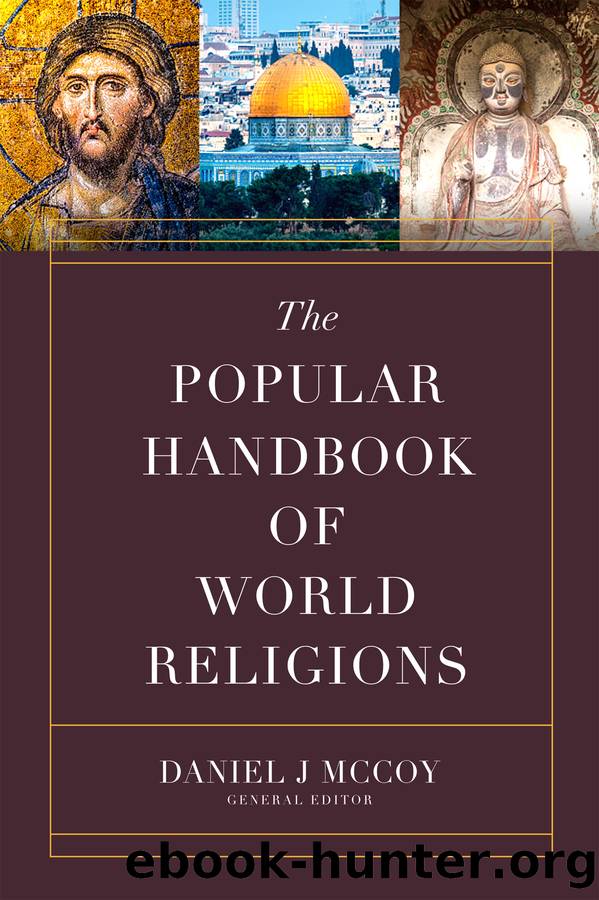The Popular Handbook of World Religions by Daniel J McCoy

Author:Daniel J McCoy
Language: eng
Format: epub
ISBN: 9780736979108
Publisher: Harvest House Publishers
Published: 2021-01-15T00:00:00+00:00
14B. Temple of Confucius in Liuzhou, Guangxi. (https://creativecommons.org/licenses/by-sa/2.0).
The basic, most fundamental understanding of Confucianism, then, is this: If each of those people behaves according to the rules, society will be great. For example, if a husband behaves in a way that a husband should, and a wife behaves in a way that a wife should, then they will have a great marriage.
This concept of great, in Confucian terms, is called âharmony.â The goal of all Confucian teaching is to help people understand the way harmony can best be achieved. Much of Confucian teaching, then, is an explanation of how each of these categories of people should behave.
Yet while Confuciusâs focus on hierarchical relationships is key to his philosophy, he also explained more general teachings about moral behavior in all relationships. For example, he believed strongly in reciprocity, which is the idea that relationships must maintain a balance of giving and receiving to be beneficial. He also encouraged familial piety, which is the deference to the needs of the family above oneself. And perhaps his most famous quoted saying is his version of the golden rule: â[Virtue] is, when you go abroad, to behave to every one as if you were receiving a great guest: to employ the people as if you were assisting at a great sacrifice; not to do to others as you would not wish done to yourself.â4
Confuciusâs teachings are given, debated, explained, and codified in several important texts, but the most foundational to Confucianism are the Five Classics and the Four Books. Confucius believed that a major part of his purpose was not just to create new teachings but also to be a translator of traditional Chinese thought into the modern age of his time. He mostly accomplished this through Five Classics, a collection of five books of various genres of traditional Chinese philosophy and practice. His own teachings were compiled and explained in the Four Books. Chief among them is the Analects, a collection of Confucian teachings collected by his followers on how a noble person should behave in each of the five relational dynamics. The other three books are compilations of commentaries, speeches, and teachings by his followers. The Four Books were officially collected and set as central Confucian doctrine during the Song Dynasty (AD 960â1279), more than 1,000 years after Confuciusâs death.
While most of Confuciusâs teachings are concerned with the proper order of society through human relationships, he incorporated certain religious elements into his instructions and seemed to believe in the existence of God.5 He spoke about a significant, if somewhat unclear, concept of God, referred to as Tian, or âHeaven.â Tian is an unseen spiritual power that is only loosely related to humanity. Despite being the supreme power, ruler, and judge over all the earth, Tian only rarely chooses to involve himself with the affairs of humanity. This primarily takes place when a government, or in this context a dynasty, is removed from power because of their inability to govern their people in a noble and selfless way and is replaced by a superior leader.
Download
This site does not store any files on its server. We only index and link to content provided by other sites. Please contact the content providers to delete copyright contents if any and email us, we'll remove relevant links or contents immediately.
Periodization Training for Sports by Tudor Bompa(8097)
The Body: A Guide for Occupants by Bill Bryson(4887)
The MacArthur Bible Commentary by John MacArthur(4680)
The Sports Rules Book by Human Kinetics(4215)
What It Really Takes to Get Into Ivy League and Other Highly Selective Colleges by Hughes Chuck(3643)
Marijuana Grower's Handbook by Ed Rosenthal(3584)
The Sprouting Book by Ann Wigmore(3510)
The Martian by Andy Weir(3250)
Salt, Fat, Acid, Heat: Mastering the Elements of Good Cooking by Nosrat Samin(3078)
The Bread Bible by Rose Levy Beranbaum(2969)
Sapiens and Homo Deus by Yuval Noah Harari(2944)
Harry Potter 4 - Harry Potter and The Goblet of Fire by J.K.Rowling(2942)
Classic by Mary Berry(2916)
The Marketing Plan Handbook: Develop Big-Picture Marketing Plans for Pennies on the Dollar by Robert W. Bly(2902)
Martha Stewart's Baking Handbook by Martha Stewart(2748)
The Plant Paradox by Dr. Steven R. Gundry M.D(2512)
Screenplay: The Foundations of Screenwriting by Syd Field(2505)
50 Economics Classics by Tom Butler-Bowdon(2484)
The Cambridge Grammar Of The English Language by Rodney Huddleston Geoffrey K. Pullum(2355)
